A Low-Profile Dual-Polarized Magneto-Electric Dipole Antenna for 5G Applications
Abstract
:1. Introduction
2. Materials and Methods
2.1. Antenna Structure
2.2. Dual-Polarized Structure
2.3. Magnetic Dipole Structure
2.4. Parametric Analysis
3. Results
4. Conclusions
Author Contributions
Funding
Institutional Review Board Statement
Informed Consent Statement
Data Availability Statement
Conflicts of Interest
References
- Ge, L.; Luk, K.M. A Wideband Magneto-Electric Dipole Antenna. IEEE Trans. Antennas Propag. 2012, 60, 4987–4991. [Google Scholar] [CrossRef]
- Wu, B.Q.; Luk, K. A Magneto-Electric Dipole with a Modified Ground Plane. IEEE Antennas Wirel. Propag. Lett. 2009, 8, 627–629. [Google Scholar]
- Zhu, Y.; Chen, Y.; Yang, S. Decoupling and Low-Profile Design of Dual-Band Dual-Polarized Base Station Antennas Using Frequency-Selective Surface. IEEE Trans. Antennas Propag. 2019, 67, 5272–5281. [Google Scholar] [CrossRef]
- Zhao, Z.; Lai, J.; Feng, B.; Sim, C. A Dual-Polarized Dual-Band Antenna with High Gain for 2G/3G/LTE Indoor Communications. IEEE Access 2018, 6, 61623–61632. [Google Scholar] [CrossRef]
- An, W.X.; Wong, H.; Lau, K.L.; Li, S.F.; Xue, Q. Design of Broadband Dual-Band Dipole for Base Station Antenna. IEEE Trans. Antennas Propag. 2012, 60, 1592–1595. [Google Scholar] [CrossRef]
- Yan, S.; Soh, P.J.; Vandenbosch, G.A.E. Wearable Dual-Band Magneto-Electric Dipole Antenna for WBAN/WLAN Applications. IEEE Trans. Antennas Propag. 2015, 63, 4165–4169. [Google Scholar] [CrossRef]
- Feng, B.; An, W.; Yin, S.; Deng, L.; Li, S. Dual-Wideband Complementary Antenna with a Dual-Layer Cross-ME-Dipole Structure for 2G/3G/LTE/WLAN Applications. IEEE Antennas Wirel. Propag. Lett. 2015, 14, 626–629. [Google Scholar] [CrossRef]
- Zhang, Z.Y.; Wu, K.L. A wideband dual-polarized dielectric magnetoelectric dipole antenna. IEEE Trans. Antennas Propag. 2018, 66, 5590–5595. [Google Scholar] [CrossRef]
- Bayarzaya, B.; Hussain, N.; Awan, W.A.; Sufian, M.A.; Abbas, A.; Choi, D.; Lee, J.; Kim, N. A Compact MIMO Antenna with Improved Isolation for ISM, Sub-6 GHz, and WLAN Application. Micromachines 2022, 13, 1355. [Google Scholar] [CrossRef]
- Rafique, U.; Khan, S.; Abbas, S.M.; Dalal, P. Uni-planar MIMO Antenna for Sub-6 GHz 5G Mobile Phone Applications. In Proceedings of the 2022 IEEE Wireless Antenna and Microwave Symposium (WAMS), Rourkela, India, 5–8 June 2022; pp. 1–5. [Google Scholar]
- Luk, K.M.; Wong, H. A new wideband unidirectional antenna element. Int. J. Microw. Opt. Technol. 2006, 1, 35–44. [Google Scholar]
- Ge, L.; Luk, K.M. A Magneto-Electric Dipole Antenna with Low-Profile and Simple Structure. IEEE Antennas Wirel. Propag. Lett. 2013, 12, 140–142. [Google Scholar] [CrossRef]
- He, K.; Gong, S.; Gao, F. A Wideband Dual-Band Magneto-Electric Dipole Antenna with Improved Feeding Structure. IEEE Antennas Wirel. Propag. Lett. 2014, 13, 1729–1732. [Google Scholar] [CrossRef]
- Ding, C.; Luk, K. Low-Profile Magneto-Electric Dipole Antenna. IEEE Antennas Wirel. Propag. Lett. 2016, 15, 1642–1644. [Google Scholar] [CrossRef]
- Ding, C.; Luk, K. Compact differential-fed dipole antenna with wide bandwidth- stable gain and low cross-polarization. Electron. Lett. 2017, 53, 1019–1021. [Google Scholar] [CrossRef]
- Siu, L.; Wong, H.; Luk, K. A Dual-Polarized Magneto-Electric Dipole with Dielectric Loading. IEEE Trans. Antennas Propag. 2009, 57, 616–623. [Google Scholar] [CrossRef]
- Zhu, C.; Wang, B.; Luo, W.; Wen, X. Dual-wideband dual-polarized magnetoelectric dipole antenna for 4G/5G microcell base station. Electron. Lett. 2020, 56, 269–271. [Google Scholar] [CrossRef]
- Lai, H.W.; Wong, H. Substrate Integrated Magneto-Electric Dipole Antenna for 5G Wi-Fi. IEEE Trans. Antennas Propag. 2015, 63, 870–874. [Google Scholar] [CrossRef]
- Yang, S.J.; Pan, Y.M.; Zhang, Y.; Gao, Y.; Zhang, X.Y. Low-Profile Dual-Polarized Filtering Magneto-Electric Dipole Antenna for 5G Applications. IEEE Trans. Antennas Propag. 2019, 67, 6235–6243. [Google Scholar] [CrossRef]
- Xu, J.; Hong, W.; Jiang, Z.H.; Zhang, H. Millimeter-Wave Broadband Substrate Integrated Magneto-Electric Dipole Arrays with Corporate Low-Profile Microstrip Feeding Structures. IEEE Trans. Antennas Propag. 2020, 68, 7056–7067. [Google Scholar] [CrossRef]
- Le Thi, C.H.; Ta, S.X.; Nguyen, X.Q.; Nguyen, K.K.; Dao-Ngoc, C. Design of compact broadband dual-polarized antenna for 5G applications. Int. J. RF Microw. Comput.-Aided Eng. 2021, 31, e22615. [Google Scholar] [CrossRef]
- Trinh-Van, S.; Yang, Y.; Lee, K.-Y.; Hwang, K.C. Low-Profile and Wideband Circularly Polarized Magneto-Electric Dipole Antenna Excited by a Cross Slot. IEEE Access 2022, 10, 52154–52161. [Google Scholar] [CrossRef]
- Feng, B.; Li, L.; Chung, K.L.; Li, Y. Wideband Wide Beam Dual Circularly Polarized Magnetoelectric Dipole Antenna/Array with Meta-Columns Loading for 5G and beyond. IEEE Trans. Antennas Propag. 2021, 69, 219–228. [Google Scholar] [CrossRef]
- Cao, W.; Zhou, M. A Novel Wideband Dual-Polarized Magneto-Electric Dipole Antenna. In Proceedings of the 2021 IEEE International Conference on Consumer Electronics and Computer Engineering (ICCECE), Guangzhou, China, 15–17 January 2021; pp. 47–50. [Google Scholar]
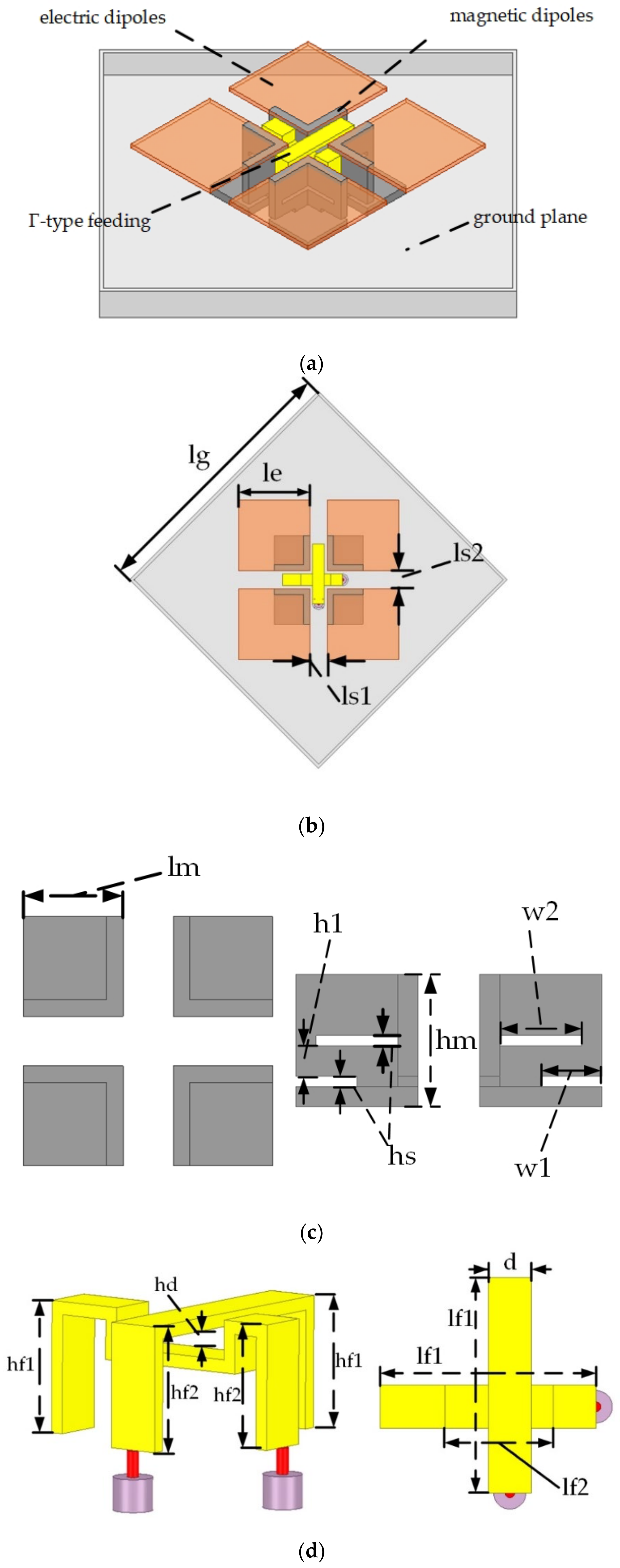
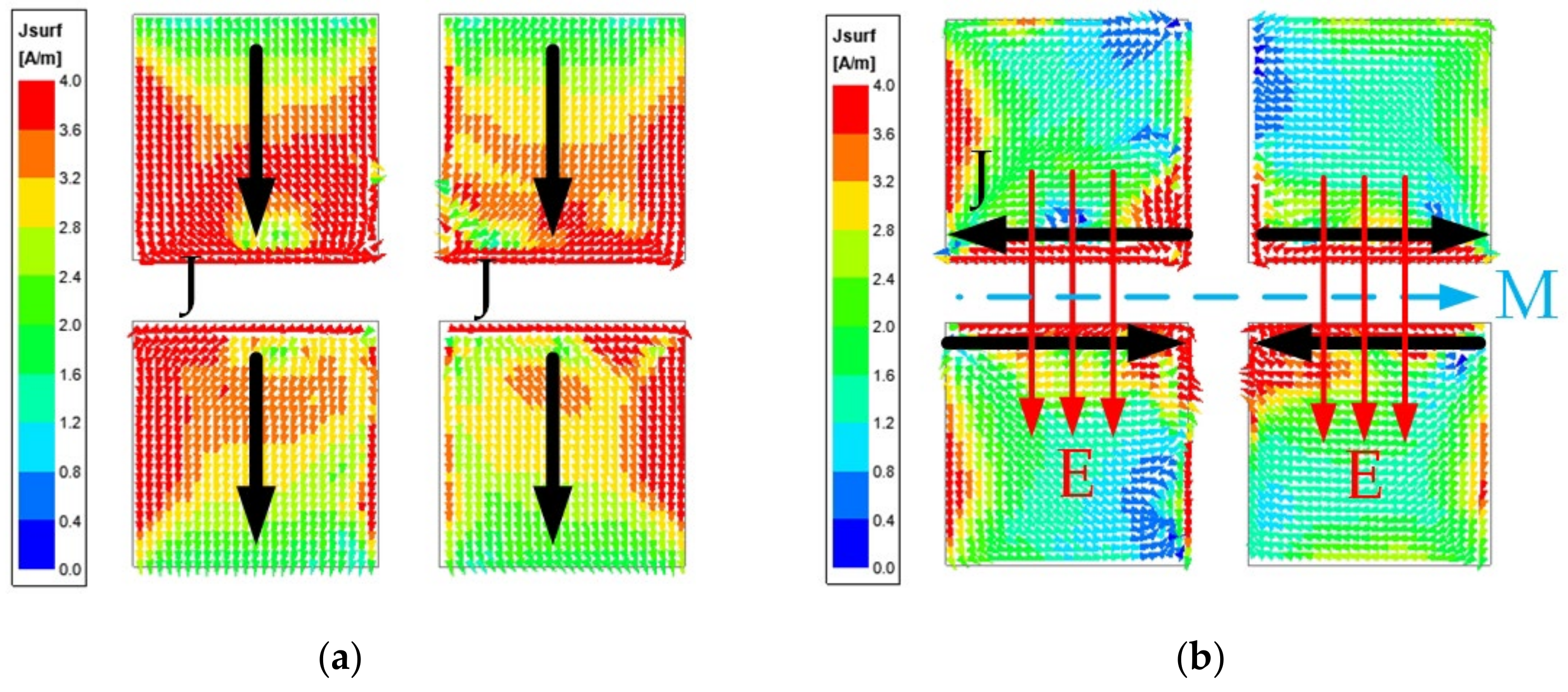
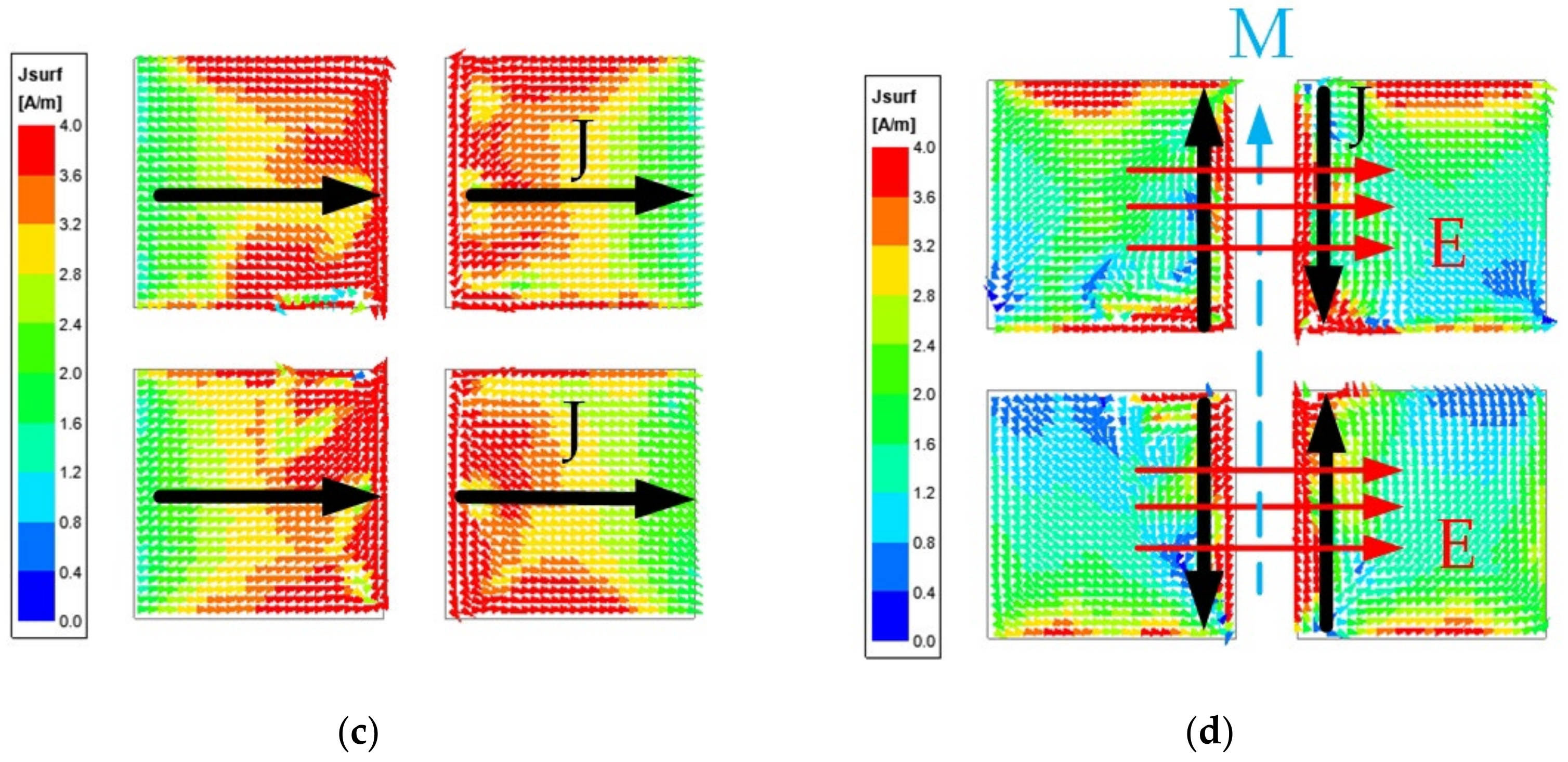
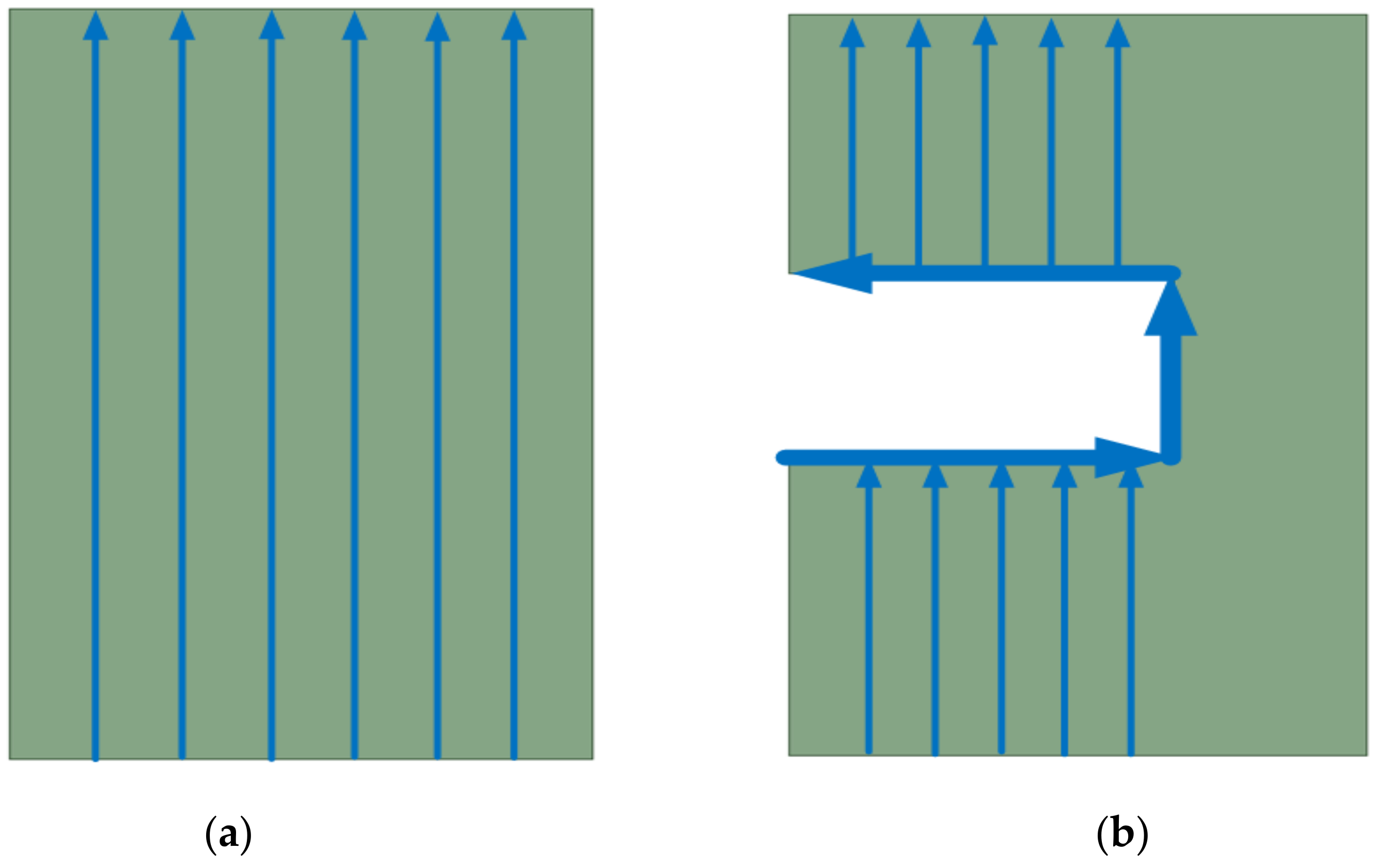
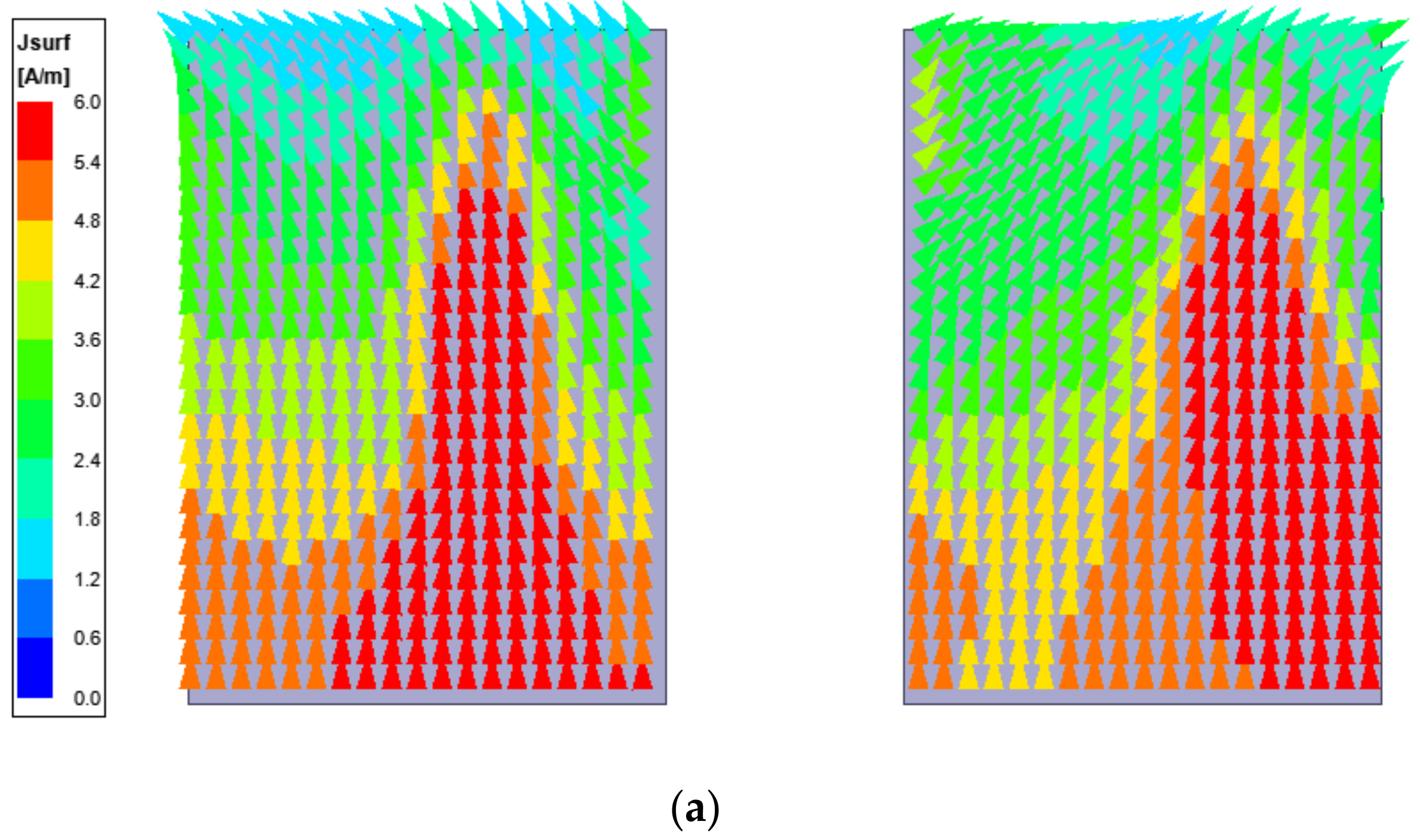
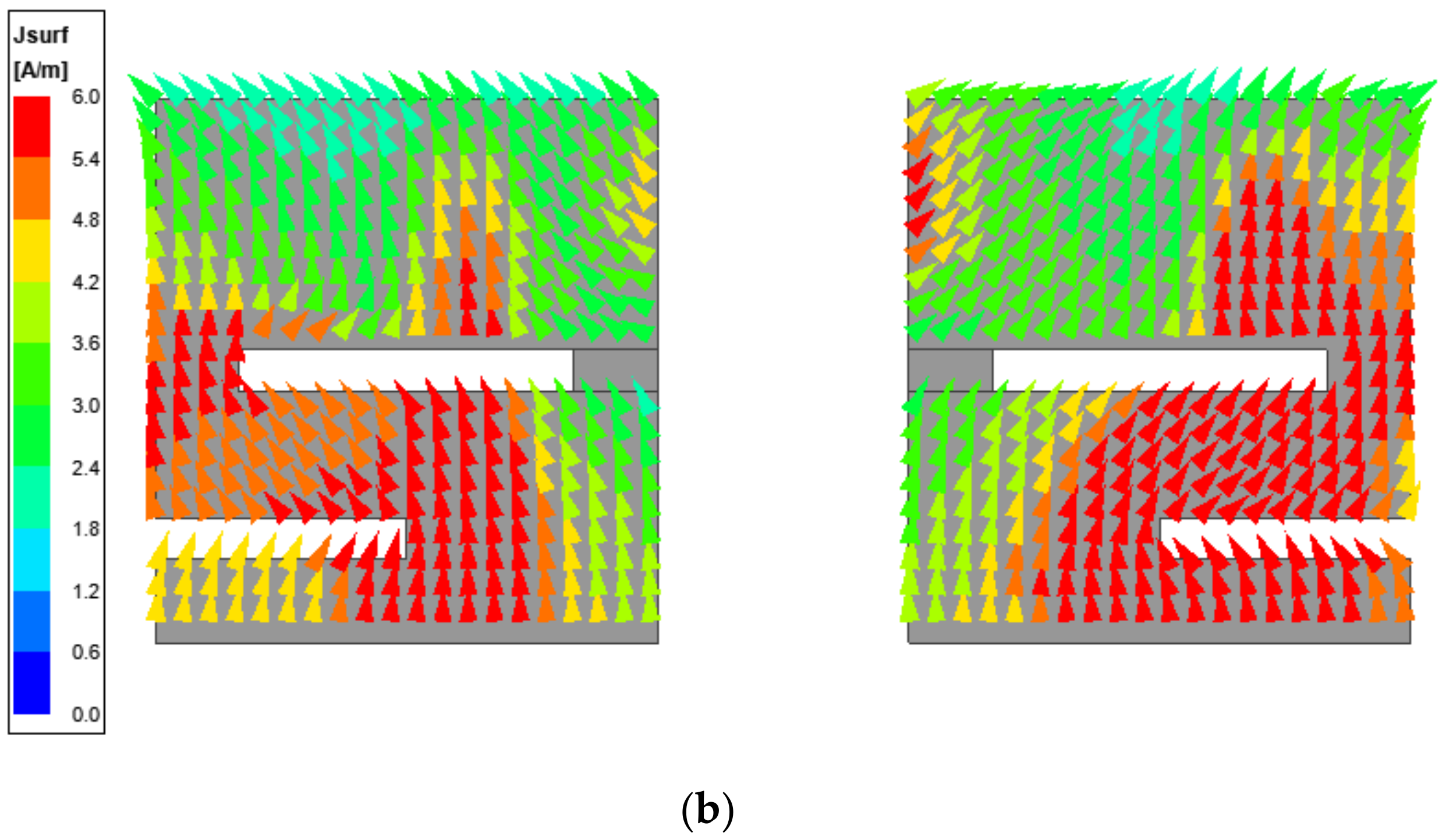


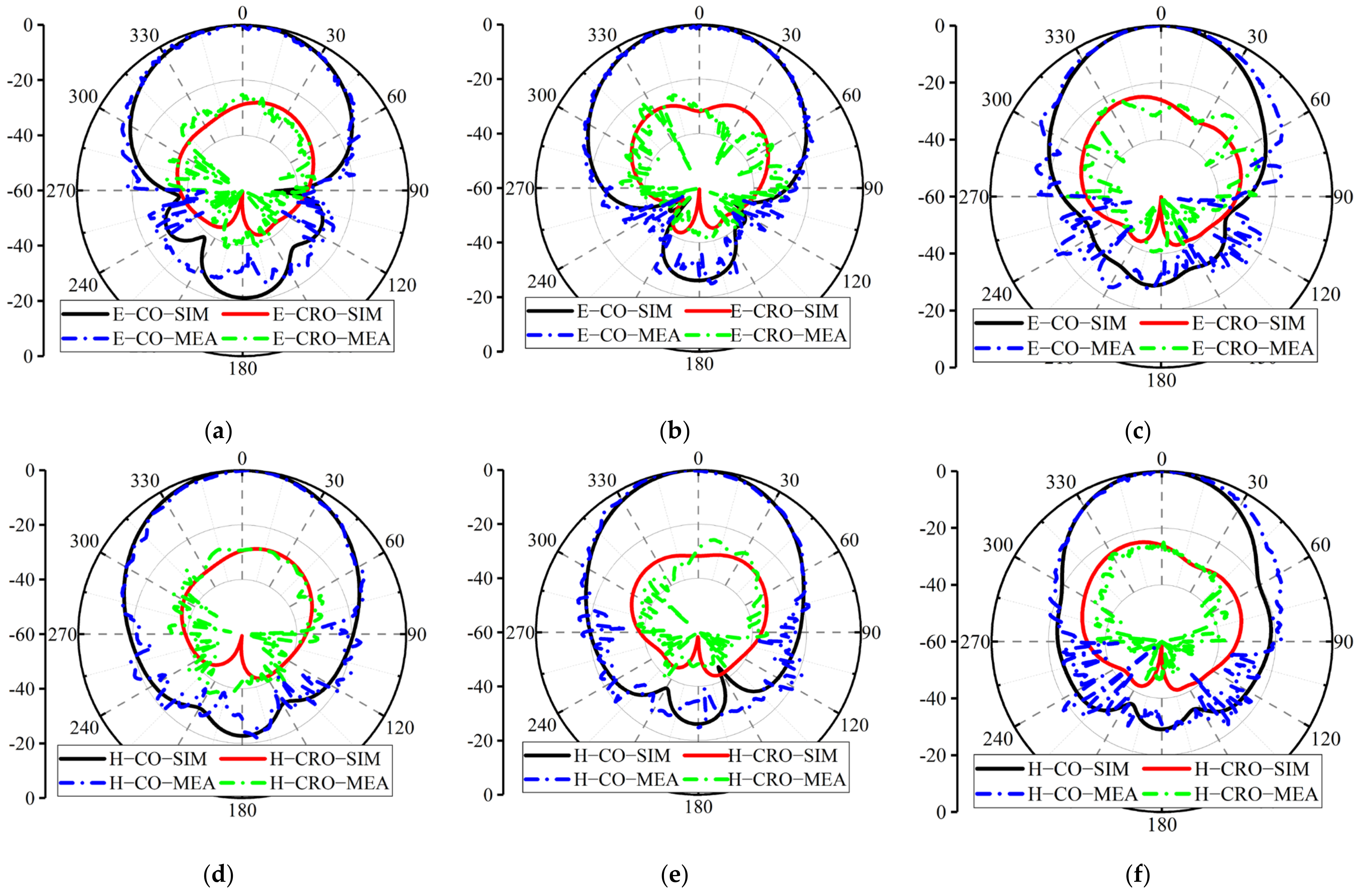


| lg | le | ls1 | ls2 | lm | hm | hs |
|---|---|---|---|---|---|---|
| 90 | 24 | 6 | 6 | 12 | 13 | 1 |
| h1 | w1 | w2 | hd | hf1 | hf2 | lf1 |
| 3 | 6 | 8 | 2 | 10 | 9.5 | 20 |
| lf2 | d | |||||
| 10 | 4 |
| Frequency | E−Plane@port1 | H−Plane@port1 | E−Plane@port2 | H−Plane@port2 |
|---|---|---|---|---|
| 3.3 GHz | 57 | 53 | 56 | 54 |
| 3.8 GHz | 47 | 48 | 47 | 48 |
| 4.3 GHz | 45 | 44 | 47 | 46 |
| Ref. | Low-Profile Design | Low-Profile Structure | Designed Polarization | Overall Volume | Gain |
|---|---|---|---|---|---|
| [11] | no | no | Single-polarization | 1 × 1 × 0.24 (λ0)3 | 8 dBi |
| [21] | Aperture coupled feed | complex | Dual- polarization | 0.58 × 0.58 × 0.15 (λ0)3 | 8.5 dBi |
| [22] | Fold the vertical shorted patch | complex | Circular-polarization | 0.93 × 0.93 × 0.18 (λ0)3 | 9.7 dBi |
| [23] | Load dielectric | complex | Circular-polarization | 0.83 × 0.83 × 0.18 (λ0)3 | 6.9 dBi |
| [24] | Tilted the vertical shorted patch | complex | Dual- polarization | 1.44 × 1.44 × 0.25 (λ0)3 | 9 dBi |
| This study | Set meander slot | simple | Dual- polarization | 1.13 × 1.13 × 0.15 (λ0)3 | 10.2 dBi |
Disclaimer/Publisher’s Note: The statements, opinions and data contained in all publications are solely those of the individual author(s) and contributor(s) and not of MDPI and/or the editor(s). MDPI and/or the editor(s) disclaim responsibility for any injury to people or property resulting from any ideas, methods, instructions or products referred to in the content. |
© 2022 by the authors. Licensee MDPI, Basel, Switzerland. This article is an open access article distributed under the terms and conditions of the Creative Commons Attribution (CC BY) license (https://creativecommons.org/licenses/by/4.0/).
Share and Cite
Zhu, Y.; Tan, Q.; Fan, K. A Low-Profile Dual-Polarized Magneto-Electric Dipole Antenna for 5G Applications. Appl. Sci. 2023, 13, 530. https://doi.org/10.3390/app13010530
Zhu Y, Tan Q, Fan K. A Low-Profile Dual-Polarized Magneto-Electric Dipole Antenna for 5G Applications. Applied Sciences. 2023; 13(1):530. https://doi.org/10.3390/app13010530
Chicago/Turabian StyleZhu, Yulong, Qingquan Tan, and Kuikui Fan. 2023. "A Low-Profile Dual-Polarized Magneto-Electric Dipole Antenna for 5G Applications" Applied Sciences 13, no. 1: 530. https://doi.org/10.3390/app13010530
APA StyleZhu, Y., Tan, Q., & Fan, K. (2023). A Low-Profile Dual-Polarized Magneto-Electric Dipole Antenna for 5G Applications. Applied Sciences, 13(1), 530. https://doi.org/10.3390/app13010530






